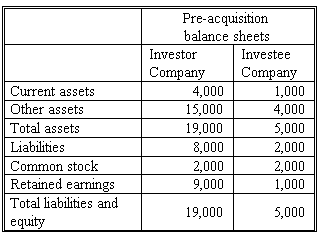Why should I choose AnalystNotes?
AnalystNotes specializes in helping candidates pass. Period.
Basic Question 4 of 6

If Investor Company, by issuing new stocks, acquires a 30% interest in Investee Company at book value, under the proportionate consolidation method, Investor Company will report total assets of
A. $20,500.
B. $19,000.
C. $24,000.
User Contributed Comments 6
| User | Comment |
|---|---|
| robbe1 | If the stake is bought with cash, total assets stays at $19k. |
| turtle | exactly :-) |
| raner | why? will the CA(Cur Asset) account be reduced by the cash paid out? |
| ilzina | if investor company obtains additional funds by issuing new shares, the assets of investor go up by 1k. so 20k -1k (payment) + 30% x5k = 20.5k |
| rodney176 | The question did mention its an all stock transaction |
| davidt876 | not at all robbe and turtle... when you purchase with cash, you gain the assets of the investee less the cost of acquisition. and because A=L+E, the assets acquired (A) will always be greater than the cost of the company' equity (E) unless Liabilities=0. so the net effect of a cash purchase is usually positive on assets. using this question, a cash purchase would be: cost = 0.3*BV of investee's equity = 0.3*(2,000+1,000) = 900 Current assets (cash) = 4000 + (0.3*1,000) - 900(cost) = 3,400 Other assets = 15,000 + (0.3*4,000) = 16,200 Total Assets = 19,600 Liabilities = 8,000 + (0.3*2,000) = 8,600 Common stock = 2,000 + (0.3*(2,000+1,000)) = 2,900 Retained earnings = 9,000 - 900(cost) = 8,100 Total liabilities & equity = 19,600 the 900 cost of acquisition is fed through the income statement to reduce equity via retained earnings - this is to balance out the decrease in assets when the investor paid out cash [A(-900) = L + E(-900)] and then everything else is just added at the % share |

I passed! I did not get a chance to tell you before the exam - but your site was excellent. I will definitely take it next year for Level II.

Tamara Schultz
Learning Outcome Statements
describe the classification, measurement, and disclosure under International Financial Reporting Standards (IFRS) for 1) investments in financial assets, 2) investments in associates, 3) joint ventures, 4) business combinations, and 5) special purpose and variable interest entities;
distinguish between IFRS and US GAAP in their classification, measurement, and disclosure of investments in financial assets, investments in associates, joint ventures, business combinations, and special purpose and variable interest entities;
analyze how different methods used to account for intercorporate investments affect financial statements and ratios.
CFA® 2025 Level II Curriculum, Volume 2, Module 10.